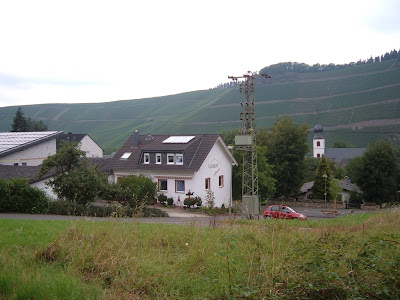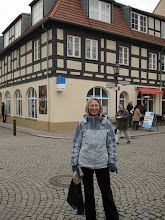Back to Germany, to the city of Trier or Treveri as it was called in Roman times. Trier is the oldest city in Germany, founded by the Romans in 16 B.C. For 300 years it was the capital of the Northern Roman province of Gallia Belgica. Today, the Roman influence is still strong in the city. The Porta Nigra, the Roman Baths, the Basilika, and the Amphitheater all testify to Treveri -- Trier's impressive Roman past.
This is the Porta Nigra (the Black Gate).

This is the Porta Nigra (the Black Gate).

The rest of the city is just as pretty, as all small cities in Germany seem to be. The houses are beautifully restored and the pedestrian mall (Fussgängerzone) is full of shops, restaurants, and cafes. This is the market square, and we lived just around the corner in a youth hostel.

In the background, connected to the Palace, you can see the Basilika, which was built by Emperor Constantine (more on him below) as his grand hall to receive guests, citizens, and dignitaries.
When we arrived in Trier, we found out that the city was celebrating the Emperor Constantine -- the first Christian Roman emperor -- who moved his residence to Trier in 306 (and thus made Trier the seat of the Western Roman Empire) and became the ''Augustus'' of Trier in 307. If you want to know more, visit http://www.konstantin-ausstellung/.
It turned out that this weekend was Roman weekend, with a Roman camp built up at the area where the ruins of the Roman baths now are. It was something like a miniature "Renaissance Festival" like they have in Maryland each fall. Same ideas of foods, crafts, bow-and-arrow contests, even jousting.
Thomas was confident of his archery skills after having done this in P.E. at school the past year. Sure enough, he put all three arrows in the deer.

One field was set up to show Roman jousting.
Eating genuine Roman stew in bread bowl (hmm... looks strangely like the bread bowl you get at the Maryland Renaissance Festival).

In the evning there was a light, dance, and sound spectacular in the underground walkways of the ancient Roman baths. This place would be great for a Halloween Spooktacular, which is what it reminded us of.

A visit to Trier would not be complete without a visit to the Karl Marx museum. Karl Marx was born in this house in Trier in 1818. The museum has a brand new exhibit about the life and influence of Karl Marx, and it also describes the turbulent history of the house itself.
To know more about Karl Marx and the museum, go to http://www.fes.de/marx/index_e.htm
Now we actually have left Trier and are on our way to Frankfurt am Main. We will stay in a hotel right by the airport in order to be ready to fly back the next morning. We took the scenic route, with a ferry over the Rhine river from Ingelheim to Oestrich-Winkel. Here you can see how flooded the river is. They were preparing for a new flooding catastrophe like back in 2005, but fortunately the water level was receding. Thomas has no time looking at such things. He is reading his latest James Bond book, "Dr. No"......
Our last dinner in Germany for this time was at this winery above the Rhine river. The view over the river valley where you can see Frankfurt, Mainz, and Wiesbaden was excellent, as was the wine and the food.



















































